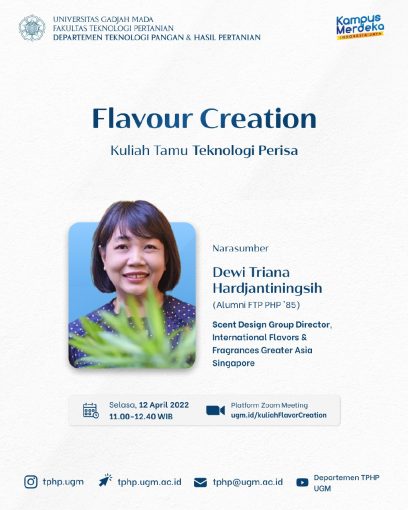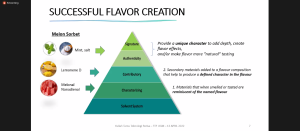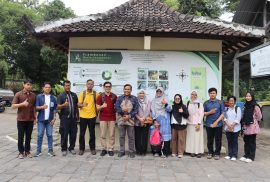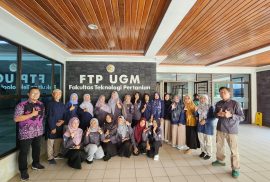
The lecture of Flavor Technology on the Department of Food and Agricultural Products Technology activity held a guest lecture on the topic of Flavor Creation. This guest lecture brought in a speaker, Dewi Triana Hardjantiningsih, who is the Scent Design Group Director, International Flavors & Fragrances Greater Asia Singapore. The guest lecture which took place on Tuesday, April 12, 2022, at 11:00 – 12:40 WIB was hosted by Dr. Ir. Supriyadi, M.Sc. and Dr. Manikharda, S.T.P., M.Agr.
Flavorists are often mistaken for food designers. Flavorist is a professional who develops new flavors using ingredients, such as individual flavor components (natural and synthetic), botanical extracts, and oils. Flavorists usually work in food and beverage companies. Meanwhile, a food designer is a food technologist who applies and optimizes the developed flavors in the final product. Food designers usually work as food technologists/scientists, chefs, or bakery specialists, and collaborate with sales, sensory and consumer insights, account managers, and flavorists.
Being a flavorist requires understanding basic ingredient composition, sensory basis, building a common language, formulation basis, and key structure of flavor formulation. Basic ingredient composition needs to know the origin of the ingredients (natural, natural identical, artificial), the process (synthesized, extracted, biotransformation), and the harvest cycle. The sensory basis must include the total eating experience, namely visual, tactile, olfactory, gustatory, and auditory. In addition, one must also understand sensory science tools, such as discriminative tests, descriptive tests, texture profiles, and taste-time intensity. Building a common language is necessary to categorize and describe flavors to provide a more detailed flavor profile. Formulation basics and key formulation structures are required to understand the existing chemical components of each flavor category to create new flavors.
The key structure of flavor formulation consists of solvent system, characterizing, contributory, authenticity, and signature. A solvent system is needed for mixing flavor composition. Characterizing is an ingredient that when smelled or tasted will show the existing flavor. Contributory is a secondary ingredient that is added to the flavor composition to produce character in the flavor. Authenticity and signature play a role in presenting a unique character to enhance mouthfeel and/or make the flavor feel more natural.
Some factors to consider before formulating include the dependency of the flavor on other ingredients (acid, sweetener, thickener), the physical form of the desired flavor (liquid water, oil soluble, emulsion, powder), solvent choice, and price. Some factors trigger innovation, namely compliance with requirements/claims (halal, vegan, natural), supply issues that will trigger flavor compatibility or duplication, and the discovery of new flavors.





